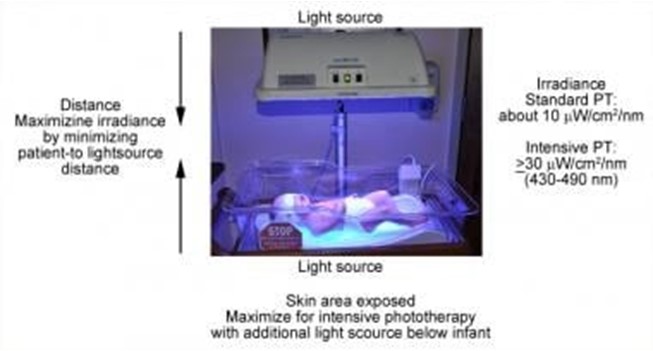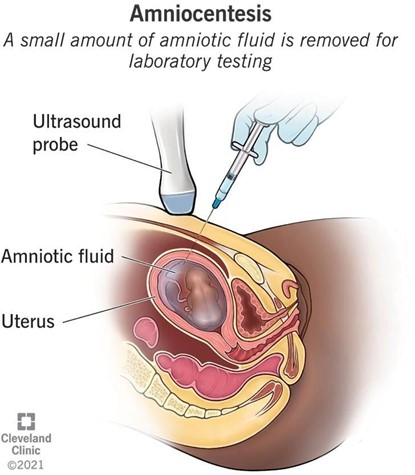A nurse is planning care for a full-term newborn who is receiving phototherapy. Which of the following actions should the nurse include in the plan of care?
Keep the newborn supine throughout treatment.
Dress the newborn in lightweight clothing.
Measure the newborn's temperature every 8 hours.
Avoid using lotion or ointment on the newborn's skin.
The Correct Answer is D
Phototherapy is a treatment that uses light to lower the level of bilirubin in the blood of newborns who have jaundice. Jaundice is a condition that causes yellowing of the skin and eyes due to high levels of bilirubin, a waste product that is normally removed by the liver. Phototherapy helps the body break down and eliminate bilirubin through urine and stool¹.
Phototherapy can be done at home or in the hospital, depending on the severity of jaundice and the type of light used. The most common types of light are fluorescent lamps, halogen lamps, or light-emitting diodes (LEDs). The light can be delivered through overhead units, fiber-optic blankets, or fiber-optic pads. The light should cover as much of the newborn's skin as possible, except for the eyes and genitals¹².
The nurse should follow certain guidelines when caring for a newborn who is receiving phototherapy, such
as:
- Monitor the newborn's temperature, hydration, weight, and urine and stool output regularly
- Protect the newborn's eyes with eye patches or goggles to prevent eye damage
- Turn the newborn every 2 to 4 hours to expose different parts of the body to the light
- Feed the newborn frequently to prevent dehydration and promote bilirubin excretion
- Check the newborn's skin color and bilirubin level periodically to evaluate the effectiveness of
phototherapy
- Provide emotional support and education to the parents about jaundice and phototherapy
One of the important guidelines is to avoid using lotion or ointment on the newborn's skin during phototherapy. This is because lotion or ointment can block the light from reaching the skin and reduce the effectiveness of phototherapy. Lotion or ointment can also cause skin irritation, rash, or burns if they react with the light. The newborn's skin should be clean and dry before phototherapy¹²³.
The other options are not actions that the nurse should include in the plan of care:
- a) Keep the newborn supine throughout treatment. This is not correct because keeping the newborn in one position can limit the exposure of different parts of the body to the light and reduce the effectiveness of phototherapy. The nurse should turn the newborn every 2 to 4 hours to expose different parts of the body to the light¹².
- b) Dress the newborn in lightweight clothing. This is not correct because dressing the newborn in clothing can block the light from reaching the skin and reduce the effectiveness of phototherapy. The newborn should be undressed except for a diaper during phototherapy¹².
- c) Measure the newborn's temperature every 8 hours. This is not correct because measuring the newborn's temperature every 8 hours may not be frequent enough to detect any changes in temperature that may occur during phototherapy. Phototherapy can cause overheating or hypothermia in newborns, depending on the type and intensity of light used. The nurse should monitor the newborn's temperature more often, such as every 2 to 4 hours, and adjust the room temperature or use blankets as needed¹².

Nursing Test Bank
Naxlex Comprehensive Predictor Exams
Related Questions
Correct Answer is C
Explanation
This is because a prescription for an amniocentesis is an indication for the administration of Rho(D) immune globulin (RhIG) to prevent RhD isoimmunization in mothers who are RhD negative¹². RhD isoimmunization is a condition where the mother's immune system produces antibodies against the RhD antigen on the baby's red blood cells, which can cause hemolytic disease of the newborn (HDN)¹². RhIG is a medication that contains antibodies against the RhD antigen, and it works by binding to and destroying any fetal red blood cells that may enter the maternal circulation, preventing the mother from making her own antibodies¹²³. RhIG is usually given to RhD negative mothers during pregnancy and after delivery if the baby is RhD positive¹².
Amniocentesis is a procedure where a needle is inserted into the uterus to obtain a sample of amniotic fluid, which contains fetal cells and other substances⁴. Amniocentesis can be done for various reasons, such as genetic testing, fetal lung maturity assessment, or infection diagnosis⁴. However, amniocentesis also carries a risk of causing bleeding or leakage of amniotic fluid, which can result in fetal-maternal hemorrhage (FMH), where fetal blood cells enter the maternal circulation⁴⁵. FMH can trigger RhD isoimmunization in RhD negative mothers, so they should receive RhIG within 72 hours of the procedure to prevent this complication⁵.
The other options are not correct because:
a) Hyperemesis gravidarum is not an indication for RhIG administration. Hyperemesis gravidarum is a condition where the mother experiences severe nausea and vomiting during pregnancy, which can cause dehydration, electrolyte imbalance, and weight loss. Hyperemesis gravidarum does not affect the blood type or compatibility of the mother and the baby, and does not increase the risk of RhD isoimmunization or HDN.
b) Rh-positive blood test results are not an indication for RhIG administration. Rh-positive blood test results mean that the mother has the RhD antigen on her red blood cells, and therefore she cannot develop antibodies against it¹². Rh-positive mothers do not need RhIG, as they are not at risk of RhD isoimmunization or HDN¹².
d) Anemia is not an indication for RhIG administration. Anemia is a condition where the mother has a low level of hemoglobin or red blood cells, which can cause fatigue, weakness, and shortness of breath. Anemia can have various causes, such as iron deficiency, bleeding, or infection. Anemia does not affect the blood type or compatibility of the mother and the baby, and does not increase the risk of RhD isoimmunization or HDN.

Correct Answer is ["3"]
Explanation
Use the following formula to calculate the amount of gentamicin to administer:
Volume (mL) = Dose (mg) / Concentration (mg/mL)
First, I need to convert the client's weight from pounds to kilograms. One pound is equal to 0.4536 kilograms. Therefore, 132 lb is equal to 132 x 0.4536 = 59.8752 kg.
Next, I need to multiply the client's weight by the prescribed dose of gentamicin per kilogram. The prescribed dose is 2 mg/kg, so the total dose is 2 x 59.8752 = 119.7504 mg.
Finally, I need to divide the total dose by the concentration of gentamicin in the injection. The concentration is 40 mg/mL, so the volume is 119.7504 / 40 = 2.99376 mL.
To round the answer to the nearest whole number, I need to look at the first decimal place. If it is 5 or more, I round up; if it is less than 5, I round down. In this case, the first decimal place is 9, which is more than 5, so I round up. Therefore, the final answer is 3 mL.
The nurse should administer 3 mL of gentamicin injection to the client.
Whether you are a student looking to ace your exams or a practicing nurse seeking to enhance your expertise , our nursing education contents will empower you with the confidence and competence to make a difference in the lives of patients and become a respected leader in the healthcare field.
Visit Naxlex, invest in your future and unlock endless possibilities with our unparalleled nursing education contents today
Report Wrong Answer on the Current Question
Do you disagree with the answer? If yes, what is your expected answer? Explain.
Kindly be descriptive with the issue you are facing.
